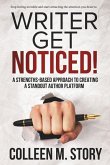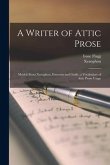- Broschiertes Buch
- Merkliste
- Auf die Merkliste
- Bewerten Bewerten
- Teilen
- Produkt teilen
- Produkterinnerung
- Produkterinnerung
Writer/Designer is a brief, accessible text that helps you compose multimodally across a range of modes, genres, and media. You learn by doing as you write for authentic audiences and purposes.
Andere Kunden interessierten sich auch für
![The Empowered Writer The Empowered Writer]() Kathleen M. MoranThe Empowered Writer61,99 €
Kathleen M. MoranThe Empowered Writer61,99 €![The Resistant Writer The Resistant Writer]() Charles PaineThe Resistant Writer34,99 €
Charles PaineThe Resistant Writer34,99 €![The Way of the Fearless Writer The Way of the Fearless Writer]() Beth KemptonThe Way of the Fearless Writer17,99 €
Beth KemptonThe Way of the Fearless Writer17,99 €![The Writer and His Craft [twenty Lectures to the Young Writer, by Robert Morss Lovett, and Others] Foreword by Roy W. Cowden The Writer and His Craft [twenty Lectures to the Young Writer, by Robert Morss Lovett, and Others] Foreword by Roy W. Cowden]() AnonymousThe Writer and His Craft [twenty Lectures to the Young Writer, by Robert Morss Lovett, and Others] Foreword by Roy W. Cowden24,99 €
AnonymousThe Writer and His Craft [twenty Lectures to the Young Writer, by Robert Morss Lovett, and Others] Foreword by Roy W. Cowden24,99 €![Maple Leaf Letter Writer [microform]: a Modern Treatise Giving Styles and Forms for All Kinds of Letters: 129 Letters on All Subjects Maple Leaf Letter Writer [microform]: a Modern Treatise Giving Styles and Forms for All Kinds of Letters: 129 Letters on All Subjects]() AnonymousMaple Leaf Letter Writer [microform]: a Modern Treatise Giving Styles and Forms for All Kinds of Letters: 129 Letters on All Subjects19,99 €
AnonymousMaple Leaf Letter Writer [microform]: a Modern Treatise Giving Styles and Forms for All Kinds of Letters: 129 Letters on All Subjects19,99 €![Writer Get Noticed! Writer Get Noticed!]() Colleen M StoryWriter Get Noticed!14,99 €
Colleen M StoryWriter Get Noticed!14,99 €![A Writer of Attic Prose: Models From Xenophon, Exercises and Guide, a Vocabulary of Attic Prose Usage A Writer of Attic Prose: Models From Xenophon, Exercises and Guide, a Vocabulary of Attic Prose Usage]() Isaac FlaggA Writer of Attic Prose: Models From Xenophon, Exercises and Guide, a Vocabulary of Attic Prose Usage21,99 €
Isaac FlaggA Writer of Attic Prose: Models From Xenophon, Exercises and Guide, a Vocabulary of Attic Prose Usage21,99 €-
-
-
Writer/Designer is a brief, accessible text that helps you compose multimodally across a range of modes, genres, and media. You learn by doing as you write for authentic audiences and purposes.
Produktdetails
- Produktdetails
- Verlag: Bedford Books
- 3rd edition
- Seitenzahl: 240
- Erscheinungstermin: 20. September 2021
- Englisch
- Abmessung: 230mm x 164mm x 10mm
- Gewicht: 358g
- ISBN-13: 9781319245054
- ISBN-10: 1319245056
- Artikelnr.: 63507857
- Herstellerkennzeichnung
- Libri GmbH
- Europaallee 1
- 36244 Bad Hersfeld
- gpsr@libri.de
- Verlag: Bedford Books
- 3rd edition
- Seitenzahl: 240
- Erscheinungstermin: 20. September 2021
- Englisch
- Abmessung: 230mm x 164mm x 10mm
- Gewicht: 358g
- ISBN-13: 9781319245054
- ISBN-10: 1319245056
- Artikelnr.: 63507857
- Herstellerkennzeichnung
- Libri GmbH
- Europaallee 1
- 36244 Bad Hersfeld
- gpsr@libri.de
Cheryl Ball; Jennifer Sheppard; Kristin Arola
Preface for Instructors Introduction for Students PART ONE The Multimodal Process 1 What Are Multimodal Projects? What Is Multimodal Composing? Why Should Multimodal Composing Matter to You? Writing/Designing as a Process The Typical Writing Process The Multimodal Composing Process Touchpoints
TOUCHPOINT: Understanding Multimodal Processes How Does Multimodality Work? Linguistic Mode Visual Mode Aural Mode Spatial Mode Gestural Mode Understanding Modes, Media, and Affordances CASE STUDY Mapping the Impact of COVID-19 Multimodal Affordances
TOUCHPOINT: Mode, Media, and Affordance in Everyday Texts WRITE/DESIGN! ASSIGNMENT: Mapping Your Multimodal Process Write/Design! Option: Multimodal Literacy Narratives 2 How Does Rhetoric Work in Multimodal Projects? Rhetoric and Multimodality Analyzing a Rhetorical Situation Author Audience
TOUCHPOINT: Analyzing Audience Purpose
TOUCHPOINT: Analyzing Purpose Context
TOUCHPOINT: Analyzing Context Analyzing Design Choices Emphasis Contrast Color Organization Alignment Proximity
TOUCHPOINT: Analyzing a Website's Rhetorical Design Choices Writing and Designing Rhetorically CASE STUDY Analyzing the Chemeketa CC Website WRITE/DESIGN! ASSIGNMENT: Designing a Rhetorical Analysis Write/Design! Option: Writing a Rhetorical Analysis 3 Why Is Genre Important in Multimodal Projects? Genre and Multimodality Genre Understanding Genre Conventions Multimodal Genres: Defining the What and the How Static and Dynamic Genres Genre Structure and Design
TOUCHPOINT: Finding Your Genre Genre Analysis: Analyzing the What and the How Analyzing Genre Conventions Questions for Genre Analysis
TOUCHPOINT: Analyzing Musical Genres CASE STUDY Analyzing Multimodal Genres in Game Studies What if the Genre Is Unclear? WRITE/DESIGN! ASSIGNMENT: Analyzing Genre Conventions for Your Project Write/Design! Option: Infographics as Visual-Argument Genres 4 How Do You Start a Multimodal Project? What Are You Supposed to Produce? Brainstorming Your Project Ideas
TOUCHPOINT: Multimodal Brainstorming Pitching Your Project Designing Your Pitch
TOUCHPOINT: Putting a Project Pitch Into Action CASE STUDY Pitching an App for the National Gallery Designing for Your Primary Audience Drafting to Stakeholder Expectations
TOUCHPOINT: Choosing a Draft Genre Using the Feedback Loop
TOUCHPOINT: Anticipating Feedback from Different Audiences WRITE/DESIGN! ASSIGNMENT: Proposing to Get It All Done Write/Design! Option: Project Timeline 5 How Do You Design and Revise with Multiple Audiences? Designing with Your Collaborators Strategies for Successful Collaboration
TOUCHPOINT: Write a Team Contract Collaborative Workflow Options
TOUCHPOINT: Planning with a Team Working Alone
TOUCHPOINT: Working Alone Isnt Really Working Alone Putting Together a Complete Draft for Your Primary Audience Delivering Drafts for Peer Review
TOUCHPOINT: Preparing Audiences for Feedback with a Delivery Plan Peer Reviewing Multimodal Projects Read/View/Use the Text Evaluate the Text Provide Constructive and Specific Feedback
TOUCHPOINT: Giving Feedback on a Rough Draft CASE STUDY Revising an Advertisement Design with Stakeholder Feedback Revising Your Multimodal Project Creating a Revision Plan Finalizing Your Project
TOUCHPOINT: Revising Your Project Creating Documentation for Your Stakeholders Collaborative Wiki In-Line Comments
TOUCHPOINT: Creating a Style Guide Reporting and Reflecting on Your Project WRITE/DESIGN! ASSIGNMENT: Reporting on Your Project Write/Design! Option: Reflecting on Your Project PART TWO The Write/Design Toolkit 6 Working with Multimodal Assets and Sources Collecting Assets
TOUCHPOINT: Building an Asset List Working with Multimodal Sources Find Credible Sources Evaluate Sources
TOUCHPOINT: Annotating Credible Sources in an Asset List Copyright Issues and Ethics Copyright Fair Use Permissions When Humans Are the Text Creative Commons
TOUCHPOINT: Tracking Copyright and CC-Licensed Work Citing Assets and Sources Provide Enough Information for Readers Use a Credible Citation Style for Your Genre
TOUCHPOINT: Finding and Citing Sources Organizing and Sharing Assets Categorize Your Files Appropriately Use Good Naming Conventions Use Version Control
TOUCHPOINT: Getting Your Assets In Order 7 Working with Technologies Choosing How to Work with Technologies
TOUCHPOINT: Learning How to Learn Deciding Between Analog and Digital What Does Your Audience Need?
TOUCHPOINT: Choosing an Analog or Digital Project Assessing Technological Affordances
TOUCHPOINT: Conducting a Technology Review Drafting Your Project: Static, Dynamic, and Timeline-Based Texts Prototyping for Static Texts Outlines Sketches Models
TOUCHPOINT: Sketching a Draft Designing Drafts of Dynamic Texts Wireframes Mock-Ups
TOUCHPOINT: Drafting Your Wireframe and Mock-Up Composing Timeline-Based Drafts Storyboards Scripts Rough Cuts
TOUCHPOINT: Drafting Your Storyboard Getting Feedback on Your Rough Drafts Preserving Your Assets with Metadata Preparing for the Multimodal Afterlife Where Are Your Project Files Located? How Long Are You Responsible for the Project?
TOUCHPOINT: Creating a Sustainability Plan Index
TOUCHPOINT: Understanding Multimodal Processes How Does Multimodality Work? Linguistic Mode Visual Mode Aural Mode Spatial Mode Gestural Mode Understanding Modes, Media, and Affordances CASE STUDY Mapping the Impact of COVID-19 Multimodal Affordances
TOUCHPOINT: Mode, Media, and Affordance in Everyday Texts WRITE/DESIGN! ASSIGNMENT: Mapping Your Multimodal Process Write/Design! Option: Multimodal Literacy Narratives 2 How Does Rhetoric Work in Multimodal Projects? Rhetoric and Multimodality Analyzing a Rhetorical Situation Author Audience
TOUCHPOINT: Analyzing Audience Purpose
TOUCHPOINT: Analyzing Purpose Context
TOUCHPOINT: Analyzing Context Analyzing Design Choices Emphasis Contrast Color Organization Alignment Proximity
TOUCHPOINT: Analyzing a Website's Rhetorical Design Choices Writing and Designing Rhetorically CASE STUDY Analyzing the Chemeketa CC Website WRITE/DESIGN! ASSIGNMENT: Designing a Rhetorical Analysis Write/Design! Option: Writing a Rhetorical Analysis 3 Why Is Genre Important in Multimodal Projects? Genre and Multimodality Genre Understanding Genre Conventions Multimodal Genres: Defining the What and the How Static and Dynamic Genres Genre Structure and Design
TOUCHPOINT: Finding Your Genre Genre Analysis: Analyzing the What and the How Analyzing Genre Conventions Questions for Genre Analysis
TOUCHPOINT: Analyzing Musical Genres CASE STUDY Analyzing Multimodal Genres in Game Studies What if the Genre Is Unclear? WRITE/DESIGN! ASSIGNMENT: Analyzing Genre Conventions for Your Project Write/Design! Option: Infographics as Visual-Argument Genres 4 How Do You Start a Multimodal Project? What Are You Supposed to Produce? Brainstorming Your Project Ideas
TOUCHPOINT: Multimodal Brainstorming Pitching Your Project Designing Your Pitch
TOUCHPOINT: Putting a Project Pitch Into Action CASE STUDY Pitching an App for the National Gallery Designing for Your Primary Audience Drafting to Stakeholder Expectations
TOUCHPOINT: Choosing a Draft Genre Using the Feedback Loop
TOUCHPOINT: Anticipating Feedback from Different Audiences WRITE/DESIGN! ASSIGNMENT: Proposing to Get It All Done Write/Design! Option: Project Timeline 5 How Do You Design and Revise with Multiple Audiences? Designing with Your Collaborators Strategies for Successful Collaboration
TOUCHPOINT: Write a Team Contract Collaborative Workflow Options
TOUCHPOINT: Planning with a Team Working Alone
TOUCHPOINT: Working Alone Isnt Really Working Alone Putting Together a Complete Draft for Your Primary Audience Delivering Drafts for Peer Review
TOUCHPOINT: Preparing Audiences for Feedback with a Delivery Plan Peer Reviewing Multimodal Projects Read/View/Use the Text Evaluate the Text Provide Constructive and Specific Feedback
TOUCHPOINT: Giving Feedback on a Rough Draft CASE STUDY Revising an Advertisement Design with Stakeholder Feedback Revising Your Multimodal Project Creating a Revision Plan Finalizing Your Project
TOUCHPOINT: Revising Your Project Creating Documentation for Your Stakeholders Collaborative Wiki In-Line Comments
TOUCHPOINT: Creating a Style Guide Reporting and Reflecting on Your Project WRITE/DESIGN! ASSIGNMENT: Reporting on Your Project Write/Design! Option: Reflecting on Your Project PART TWO The Write/Design Toolkit 6 Working with Multimodal Assets and Sources Collecting Assets
TOUCHPOINT: Building an Asset List Working with Multimodal Sources Find Credible Sources Evaluate Sources
TOUCHPOINT: Annotating Credible Sources in an Asset List Copyright Issues and Ethics Copyright Fair Use Permissions When Humans Are the Text Creative Commons
TOUCHPOINT: Tracking Copyright and CC-Licensed Work Citing Assets and Sources Provide Enough Information for Readers Use a Credible Citation Style for Your Genre
TOUCHPOINT: Finding and Citing Sources Organizing and Sharing Assets Categorize Your Files Appropriately Use Good Naming Conventions Use Version Control
TOUCHPOINT: Getting Your Assets In Order 7 Working with Technologies Choosing How to Work with Technologies
TOUCHPOINT: Learning How to Learn Deciding Between Analog and Digital What Does Your Audience Need?
TOUCHPOINT: Choosing an Analog or Digital Project Assessing Technological Affordances
TOUCHPOINT: Conducting a Technology Review Drafting Your Project: Static, Dynamic, and Timeline-Based Texts Prototyping for Static Texts Outlines Sketches Models
TOUCHPOINT: Sketching a Draft Designing Drafts of Dynamic Texts Wireframes Mock-Ups
TOUCHPOINT: Drafting Your Wireframe and Mock-Up Composing Timeline-Based Drafts Storyboards Scripts Rough Cuts
TOUCHPOINT: Drafting Your Storyboard Getting Feedback on Your Rough Drafts Preserving Your Assets with Metadata Preparing for the Multimodal Afterlife Where Are Your Project Files Located? How Long Are You Responsible for the Project?
TOUCHPOINT: Creating a Sustainability Plan Index
Preface for Instructors Introduction for Students PART ONE The Multimodal Process 1 What Are Multimodal Projects? What Is Multimodal Composing? Why Should Multimodal Composing Matter to You? Writing/Designing as a Process The Typical Writing Process The Multimodal Composing Process Touchpoints
TOUCHPOINT: Understanding Multimodal Processes How Does Multimodality Work? Linguistic Mode Visual Mode Aural Mode Spatial Mode Gestural Mode Understanding Modes, Media, and Affordances CASE STUDY Mapping the Impact of COVID-19 Multimodal Affordances
TOUCHPOINT: Mode, Media, and Affordance in Everyday Texts WRITE/DESIGN! ASSIGNMENT: Mapping Your Multimodal Process Write/Design! Option: Multimodal Literacy Narratives 2 How Does Rhetoric Work in Multimodal Projects? Rhetoric and Multimodality Analyzing a Rhetorical Situation Author Audience
TOUCHPOINT: Analyzing Audience Purpose
TOUCHPOINT: Analyzing Purpose Context
TOUCHPOINT: Analyzing Context Analyzing Design Choices Emphasis Contrast Color Organization Alignment Proximity
TOUCHPOINT: Analyzing a Website's Rhetorical Design Choices Writing and Designing Rhetorically CASE STUDY Analyzing the Chemeketa CC Website WRITE/DESIGN! ASSIGNMENT: Designing a Rhetorical Analysis Write/Design! Option: Writing a Rhetorical Analysis 3 Why Is Genre Important in Multimodal Projects? Genre and Multimodality Genre Understanding Genre Conventions Multimodal Genres: Defining the What and the How Static and Dynamic Genres Genre Structure and Design
TOUCHPOINT: Finding Your Genre Genre Analysis: Analyzing the What and the How Analyzing Genre Conventions Questions for Genre Analysis
TOUCHPOINT: Analyzing Musical Genres CASE STUDY Analyzing Multimodal Genres in Game Studies What if the Genre Is Unclear? WRITE/DESIGN! ASSIGNMENT: Analyzing Genre Conventions for Your Project Write/Design! Option: Infographics as Visual-Argument Genres 4 How Do You Start a Multimodal Project? What Are You Supposed to Produce? Brainstorming Your Project Ideas
TOUCHPOINT: Multimodal Brainstorming Pitching Your Project Designing Your Pitch
TOUCHPOINT: Putting a Project Pitch Into Action CASE STUDY Pitching an App for the National Gallery Designing for Your Primary Audience Drafting to Stakeholder Expectations
TOUCHPOINT: Choosing a Draft Genre Using the Feedback Loop
TOUCHPOINT: Anticipating Feedback from Different Audiences WRITE/DESIGN! ASSIGNMENT: Proposing to Get It All Done Write/Design! Option: Project Timeline 5 How Do You Design and Revise with Multiple Audiences? Designing with Your Collaborators Strategies for Successful Collaboration
TOUCHPOINT: Write a Team Contract Collaborative Workflow Options
TOUCHPOINT: Planning with a Team Working Alone
TOUCHPOINT: Working Alone Isnt Really Working Alone Putting Together a Complete Draft for Your Primary Audience Delivering Drafts for Peer Review
TOUCHPOINT: Preparing Audiences for Feedback with a Delivery Plan Peer Reviewing Multimodal Projects Read/View/Use the Text Evaluate the Text Provide Constructive and Specific Feedback
TOUCHPOINT: Giving Feedback on a Rough Draft CASE STUDY Revising an Advertisement Design with Stakeholder Feedback Revising Your Multimodal Project Creating a Revision Plan Finalizing Your Project
TOUCHPOINT: Revising Your Project Creating Documentation for Your Stakeholders Collaborative Wiki In-Line Comments
TOUCHPOINT: Creating a Style Guide Reporting and Reflecting on Your Project WRITE/DESIGN! ASSIGNMENT: Reporting on Your Project Write/Design! Option: Reflecting on Your Project PART TWO The Write/Design Toolkit 6 Working with Multimodal Assets and Sources Collecting Assets
TOUCHPOINT: Building an Asset List Working with Multimodal Sources Find Credible Sources Evaluate Sources
TOUCHPOINT: Annotating Credible Sources in an Asset List Copyright Issues and Ethics Copyright Fair Use Permissions When Humans Are the Text Creative Commons
TOUCHPOINT: Tracking Copyright and CC-Licensed Work Citing Assets and Sources Provide Enough Information for Readers Use a Credible Citation Style for Your Genre
TOUCHPOINT: Finding and Citing Sources Organizing and Sharing Assets Categorize Your Files Appropriately Use Good Naming Conventions Use Version Control
TOUCHPOINT: Getting Your Assets In Order 7 Working with Technologies Choosing How to Work with Technologies
TOUCHPOINT: Learning How to Learn Deciding Between Analog and Digital What Does Your Audience Need?
TOUCHPOINT: Choosing an Analog or Digital Project Assessing Technological Affordances
TOUCHPOINT: Conducting a Technology Review Drafting Your Project: Static, Dynamic, and Timeline-Based Texts Prototyping for Static Texts Outlines Sketches Models
TOUCHPOINT: Sketching a Draft Designing Drafts of Dynamic Texts Wireframes Mock-Ups
TOUCHPOINT: Drafting Your Wireframe and Mock-Up Composing Timeline-Based Drafts Storyboards Scripts Rough Cuts
TOUCHPOINT: Drafting Your Storyboard Getting Feedback on Your Rough Drafts Preserving Your Assets with Metadata Preparing for the Multimodal Afterlife Where Are Your Project Files Located? How Long Are You Responsible for the Project?
TOUCHPOINT: Creating a Sustainability Plan Index
TOUCHPOINT: Understanding Multimodal Processes How Does Multimodality Work? Linguistic Mode Visual Mode Aural Mode Spatial Mode Gestural Mode Understanding Modes, Media, and Affordances CASE STUDY Mapping the Impact of COVID-19 Multimodal Affordances
TOUCHPOINT: Mode, Media, and Affordance in Everyday Texts WRITE/DESIGN! ASSIGNMENT: Mapping Your Multimodal Process Write/Design! Option: Multimodal Literacy Narratives 2 How Does Rhetoric Work in Multimodal Projects? Rhetoric and Multimodality Analyzing a Rhetorical Situation Author Audience
TOUCHPOINT: Analyzing Audience Purpose
TOUCHPOINT: Analyzing Purpose Context
TOUCHPOINT: Analyzing Context Analyzing Design Choices Emphasis Contrast Color Organization Alignment Proximity
TOUCHPOINT: Analyzing a Website's Rhetorical Design Choices Writing and Designing Rhetorically CASE STUDY Analyzing the Chemeketa CC Website WRITE/DESIGN! ASSIGNMENT: Designing a Rhetorical Analysis Write/Design! Option: Writing a Rhetorical Analysis 3 Why Is Genre Important in Multimodal Projects? Genre and Multimodality Genre Understanding Genre Conventions Multimodal Genres: Defining the What and the How Static and Dynamic Genres Genre Structure and Design
TOUCHPOINT: Finding Your Genre Genre Analysis: Analyzing the What and the How Analyzing Genre Conventions Questions for Genre Analysis
TOUCHPOINT: Analyzing Musical Genres CASE STUDY Analyzing Multimodal Genres in Game Studies What if the Genre Is Unclear? WRITE/DESIGN! ASSIGNMENT: Analyzing Genre Conventions for Your Project Write/Design! Option: Infographics as Visual-Argument Genres 4 How Do You Start a Multimodal Project? What Are You Supposed to Produce? Brainstorming Your Project Ideas
TOUCHPOINT: Multimodal Brainstorming Pitching Your Project Designing Your Pitch
TOUCHPOINT: Putting a Project Pitch Into Action CASE STUDY Pitching an App for the National Gallery Designing for Your Primary Audience Drafting to Stakeholder Expectations
TOUCHPOINT: Choosing a Draft Genre Using the Feedback Loop
TOUCHPOINT: Anticipating Feedback from Different Audiences WRITE/DESIGN! ASSIGNMENT: Proposing to Get It All Done Write/Design! Option: Project Timeline 5 How Do You Design and Revise with Multiple Audiences? Designing with Your Collaborators Strategies for Successful Collaboration
TOUCHPOINT: Write a Team Contract Collaborative Workflow Options
TOUCHPOINT: Planning with a Team Working Alone
TOUCHPOINT: Working Alone Isnt Really Working Alone Putting Together a Complete Draft for Your Primary Audience Delivering Drafts for Peer Review
TOUCHPOINT: Preparing Audiences for Feedback with a Delivery Plan Peer Reviewing Multimodal Projects Read/View/Use the Text Evaluate the Text Provide Constructive and Specific Feedback
TOUCHPOINT: Giving Feedback on a Rough Draft CASE STUDY Revising an Advertisement Design with Stakeholder Feedback Revising Your Multimodal Project Creating a Revision Plan Finalizing Your Project
TOUCHPOINT: Revising Your Project Creating Documentation for Your Stakeholders Collaborative Wiki In-Line Comments
TOUCHPOINT: Creating a Style Guide Reporting and Reflecting on Your Project WRITE/DESIGN! ASSIGNMENT: Reporting on Your Project Write/Design! Option: Reflecting on Your Project PART TWO The Write/Design Toolkit 6 Working with Multimodal Assets and Sources Collecting Assets
TOUCHPOINT: Building an Asset List Working with Multimodal Sources Find Credible Sources Evaluate Sources
TOUCHPOINT: Annotating Credible Sources in an Asset List Copyright Issues and Ethics Copyright Fair Use Permissions When Humans Are the Text Creative Commons
TOUCHPOINT: Tracking Copyright and CC-Licensed Work Citing Assets and Sources Provide Enough Information for Readers Use a Credible Citation Style for Your Genre
TOUCHPOINT: Finding and Citing Sources Organizing and Sharing Assets Categorize Your Files Appropriately Use Good Naming Conventions Use Version Control
TOUCHPOINT: Getting Your Assets In Order 7 Working with Technologies Choosing How to Work with Technologies
TOUCHPOINT: Learning How to Learn Deciding Between Analog and Digital What Does Your Audience Need?
TOUCHPOINT: Choosing an Analog or Digital Project Assessing Technological Affordances
TOUCHPOINT: Conducting a Technology Review Drafting Your Project: Static, Dynamic, and Timeline-Based Texts Prototyping for Static Texts Outlines Sketches Models
TOUCHPOINT: Sketching a Draft Designing Drafts of Dynamic Texts Wireframes Mock-Ups
TOUCHPOINT: Drafting Your Wireframe and Mock-Up Composing Timeline-Based Drafts Storyboards Scripts Rough Cuts
TOUCHPOINT: Drafting Your Storyboard Getting Feedback on Your Rough Drafts Preserving Your Assets with Metadata Preparing for the Multimodal Afterlife Where Are Your Project Files Located? How Long Are You Responsible for the Project?
TOUCHPOINT: Creating a Sustainability Plan Index

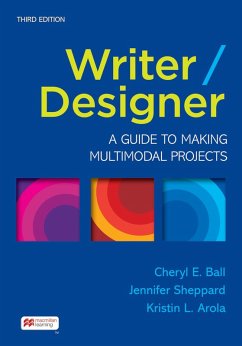
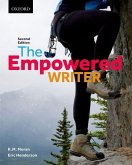

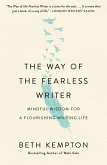
![The Writer and His Craft [twenty Lectures to the Young Writer, by Robert Morss Lovett, and Others] Foreword by Roy W. Cowden The Writer and His Craft [twenty Lectures to the Young Writer, by Robert Morss Lovett, and Others] Foreword by Roy W. Cowden](https://bilder.buecher.de/produkte/65/65569/65569787m.jpg)
![Maple Leaf Letter Writer [microform]: a Modern Treatise Giving Styles and Forms for All Kinds of Letters: 129 Letters on All Subjects Maple Leaf Letter Writer [microform]: a Modern Treatise Giving Styles and Forms for All Kinds of Letters: 129 Letters on All Subjects](https://bilder.buecher.de/produkte/65/65633/65633537m.jpg)
